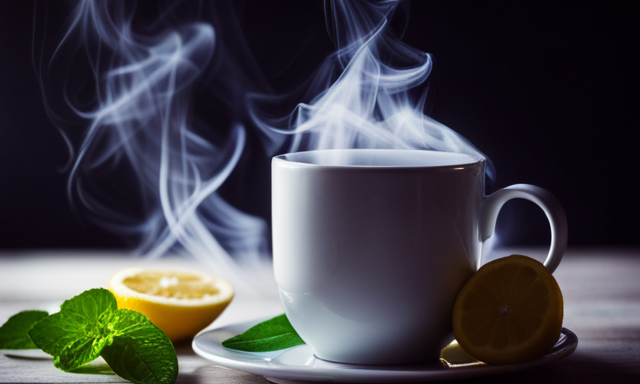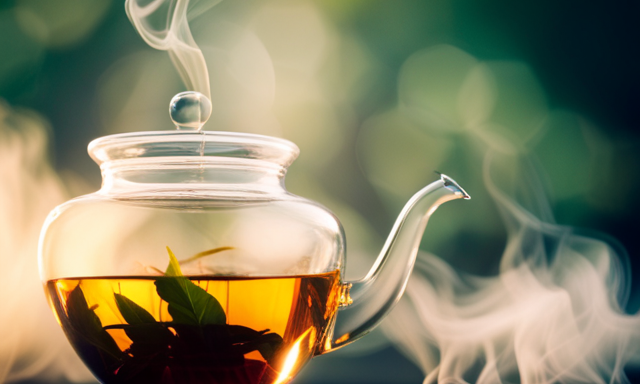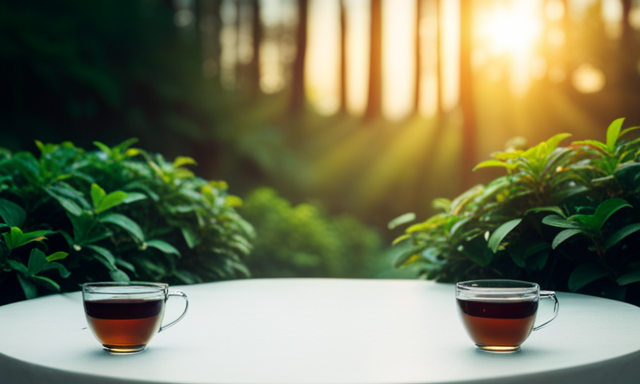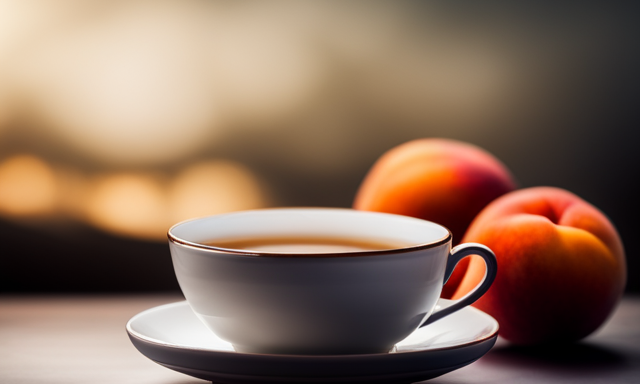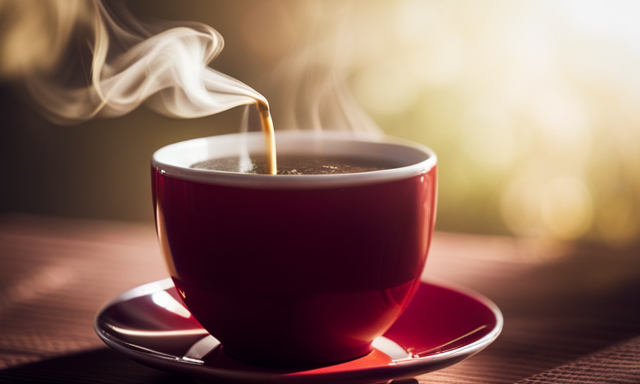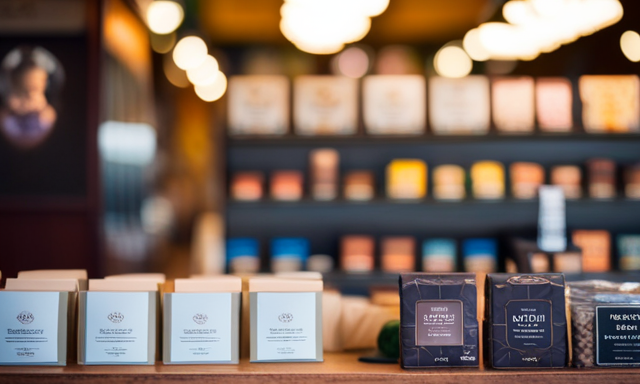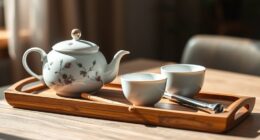Are you tired of the same old bland oolong tea? Do you long for a more flavorful and enjoyable tea-drinking experience? Well, you’re in luck! In this article, I will share with you some tried and true methods to make your oolong tea taste better.
As a tea enthusiast myself, I have spent countless hours experimenting with different techniques and ingredients to elevate the flavor profile of this beloved beverage. From choosing high-quality tea leaves to exploring various brewing methods, I will provide you with all the knowledge you need to enhance the taste of your oolong tea.
So, whether you’re a seasoned tea connoisseur or just starting your tea journey, get ready to embark on a flavor adventure and discover the secrets to making your oolong tea absolutely delicious.
Key Takeaways
- Experiment with different tea-water ratios to find your preferred taste
- Explore different brewing methods to bring out unique flavors and aromas
- Properly store oolong tea in an airtight container to preserve its delicate flavor
- Pair oolong tea with complementary flavors like milk, floral herbs, or fruits to enhance its taste profile
Choose High-Quality Oolong Tea Leaves
To make your oolong tea taste better, opt for high-quality oolong tea leaves. Investing in high-quality leaves will ensure a more robust and flavorful cup of tea. Start by understanding the different oolong tea varieties available, such as Tie Guan Yin or Da Hong Pao, each offering its unique aroma and taste profile.
Experimenting with different brewing techniques can also enhance the flavor of your oolong tea. Try using a gaiwan or a teapot to steep the leaves and discover which method brings out the best flavors.
Lastly, don’t forget to adjust the steeping time and temperature according to your preference. By understanding the characteristics of your oolong tea and experimenting with different brewing techniques, you can unlock a world of delightful flavors.
Experiment with Steeping Times and Temperatures
By adjusting the steeping times and temperatures, you can unlock a world of flavor enhancements for your oolong tea. Steeping techniques play a crucial role in bringing out the best flavors in your tea leaves.
Different oolong teas have different optimal steeping times and temperatures, so it’s important to experiment and find what works best for your specific tea. Generally, oolong teas are best steeped between 176°F and 203°F (80°C and 95°C) for 2-5 minutes. However, some teas may benefit from a longer steeping time or a slightly higher temperature.
By varying these factors, you can discover new dimensions of flavor in your oolong tea. The right combination of steeping time and temperature can bring out the tea’s natural sweetness, floral notes, or even a hint of toasty flavor. So, don’t be afraid to play around and find your perfect steeping technique to enhance the flavor of your oolong tea.
This will set the stage for the next step where we can explore how to enhance the flavor with natural additions.
Enhance the Flavor with Natural Additions
When it comes to enhancing the flavor of oolong tea, there are several natural additions that can be used.
One option is to add fresh fruit or herbs, such as slices of orange or sprigs of mint, which can infuse the tea with a refreshing and aromatic taste.
Another way to sweeten the tea is by using honey or maple syrup, which not only adds sweetness but also brings out the natural flavors of the tea.
Lastly, infusing the tea with citrus zest or spices like cinnamon or ginger can add a bold and unique twist to the flavor profile of the oolong tea.
Add Fresh Fruit or Herbs
Infuse your oolong tea with the vibrant essence of fresh fruit or aromatic herbs. This will transform it into a symphony of flavors that dance upon your palate.
To enhance the taste of oolong tea, consider adding a fruit garnish such as sliced strawberries or a squeeze of lemon juice. These additions not only add a burst of sweetness but also introduce a refreshing twist to the tea.
Another option is to infuse your oolong tea with herbal tea, such as mint or chamomile. This creates a unique and delightful blend of flavors. The herbal infusion adds depth and complexity to the tea, making each sip a truly enjoyable experience.
Transitioning into the next section, sweetening your oolong tea with honey or maple syrup further enhances its taste. This provides a touch of natural sweetness that complements the fruit and herbal notes perfectly.
Sweeten with Honey or Maple Syrup
To elevate your oolong tea experience, why not sweeten it with a touch of honey or maple syrup? These alternative sweeteners not only add a delightful sweetness but also enhance the overall flavor profile of the tea. When using honey, opt for a raw and unfiltered variety to maximize its health benefits. Maple syrup, on the other hand, brings a unique depth and richness to the brew.
To experiment with flavor combinations, consider adding fresh fruit or herbs alongside the sweeteners. For instance, a drizzle of honey pairs wonderfully with sliced peaches or a sprig of mint, while maple syrup complements the earthiness of fresh berries or a hint of basil.
By sweetening your oolong tea with honey or maple syrup and incorporating various flavor combinations, you can create a personalized and delightful tea experience. In the next section, let’s explore how to infuse oolong tea with citrus zest or spices to further enhance its taste.
Infuse with Citrus Zest or Spices
After exploring the option of sweetening oolong tea with honey or maple syrup, let’s delve into another exciting way to enhance the flavor profile of this beloved beverage.
One method that I highly recommend is infusing oolong tea with citrus zest or spices. By adding a burst of citrusy goodness or a touch of warmth from spices, you can elevate your oolong tea experience to new heights.
For a refreshing twist, try steeping your oolong tea with a hint of citrus zest, such as lemon or orange. The zesty aroma and tangy notes will beautifully complement the natural floral and fruity undertones of oolong tea.
On the other hand, if you prefer a more robust and aromatic brew, consider infusing your oolong tea with spices like cinnamon, cardamom, or ginger. These spices will impart a delightful complexity and add a cozy warmth to your cup.
Now, let’s move on to the next step in brewing the perfect oolong tea: using filtered water.
Use Filtered Water for Brewing
For a tastier oolong tea, it is recommended to use filtered water when brewing. This helps enhance the flavors by removing impurities and minerals that can alter the taste. Experiment with different brewing techniques to find the perfect balance of flavors.
Using filtered water ensures that the pure flavors of the tea shine through, making each sip more enjoyable. It’s interesting to note how the quality of the water can affect the overall taste of your tea. Have you ever wondered about this?
Well, it does make a difference! So, if you want to fully appreciate the flavors of your oolong tea, using filtered water is a must. It’s worth the investment to ensure that the tea tastes its best.
In addition to brewing, you can also explore using oolong tea in cooking recipes to add a unique twist to your dishes. The versatility of oolong tea can be a delightful surprise in culinary experiments.
To take your oolong tea experience to the next level, it’s also worth considering investing in a good quality tea infuser or teapot. This will be discussed in the next section about ‘investing in a good quality tea infuser or teapot’.
Invest in a Good Quality Tea Infuser or Teapot
Investing in a high-quality tea infuser or teapot can elevate your oolong tea experience. It allows the rich flavors to bloom and transports you to a world of aromatic bliss.
A good tea set enhances the brewing process. It ensures that the tea leaves are steeped evenly and the flavors are fully extracted. It also prevents any unwanted residue or particles from entering your cup, resulting in a smoother, more enjoyable tea.
Additionally, a good tea set gives you the opportunity to explore different brewing techniques. For example, gongfu style or grandpa style can bring out unique flavors and aromas in your oolong tea.
By investing in a tea set, you are investing in a more refined and satisfying tea experience.
Now, let’s consider the tea-water ratio to further enhance the taste of your oolong tea.
Consider the Tea-Water Ratio
Now that we have our good quality tea infuser or teapot, let’s move on to the next step in making oolong tea taste better. It’s time to consider the tea-water ratio.
This is an important factor that can greatly affect the taste of your tea. The ideal ratio for oolong tea is 1 teaspoon of tea leaves for every 8 ounces of water. However, this can vary depending on personal taste preferences. Some may prefer a stronger flavor and choose to use more tea leaves, while others may prefer a milder taste and use less.
Experimenting with different tea blends and adjusting the tea-water ratio to suit your personal preferences is key to making a delicious cup of oolong tea.
So, let’s move on to the next section and try different brewing methods to further enhance the flavor of our tea.
Try Different Brewing Methods
Let’s explore different brewing methods to discover the unique flavors and aromas that can be unlocked from oolong tea. Imagine the rich, complex notes that emerge when using a traditional gongfu tea ceremony, where the leaves are steeped multiple times in small clay teapots. This method allows for a more controlled brewing process, resulting in a full-bodied and flavorful cup of oolong tea. Additionally, experimenting with different tea varieties can also enhance the taste. Each variety has its own distinct characteristics, ranging from floral and fruity to woody and nutty. Don’t be afraid to try them all and find your favorite. Another interesting way to enjoy oolong tea is by steeping it with milk. This adds a creamy and velvety texture to the tea, creating a delightful and indulgent experience. Now, let’s move on to the next section and learn how to store oolong tea properly.
Store Oolong Tea Properly
To ensure the optimal flavor and freshness of your oolong tea, you’ll want to store it properly. Proper storage techniques are essential in maintaining the quality and taste of this exquisite tea.
Oolong tea should be stored in an airtight container, away from light, heat, and moisture. This helps to preserve its delicate flavor and prevent it from absorbing any unwanted odors.
Additionally, storing oolong tea in a cool and dark place, such as a cupboard or pantry, can extend its shelf life. By following these guidelines, you can ensure that your oolong tea stays fresh and flavorful for a longer period of time.
Moreover, oolong tea offers numerous health benefits, including boosting metabolism and aiding in weight loss. It contains antioxidants and polyphenols that promote overall well-being.
Moving on to the next topic, let’s explore how to pair oolong tea with complementary flavors.
Pair Oolong Tea with Complementary Flavors
Enhance the exquisite flavor of your oolong tea by pairing it with complementary flavors. To create a truly delightful experience, consider infusing your oolong tea with milk. This not only adds a creamy texture but also enhances the natural sweetness of the tea. Additionally, exploring different tea blends can introduce exciting new taste profiles. For example, pairing oolong tea with floral herbs like jasmine or lavender can create a delicate and aromatic infusion. Alternatively, blending oolong tea with fruits like peach or citrus can add a refreshing twist. To guide you in your flavor experiments, here’s a table showcasing some wonderful flavor combinations:
| Complementary Flavor | Oolong Tea Blend |
|---|---|
| Jasmine | Green Oolong |
| Lavender | Black Oolong |
| Peach | White Oolong |
| Citrus | Dark Oolong |
With these pairing ideas in mind, you can now experiment and enjoy the endless possibilities of enhancing the flavor of your oolong tea.
Experiment and Enjoy!
Immerse yourself in a world of flavor exploration and savor the delightful symphony of tastes that await your palate. When it comes to making oolong tea taste better, one of the best ways is to experiment and enjoy the process.
Tea tasting techniques can help you discover the nuances and complexities of different oolong teas. Start by using different water temperatures and steeping times to bring out unique flavors. Don’t be afraid to try different brewing methods such as gongfu style or using a teapot.
The benefits of tea experimentation are endless – you can find your perfect balance of sweetness, bitterness, and aroma. With each cup, you’ll uncover new flavors and appreciate the art of tea-making even more.
So, go ahead, let your taste buds guide you on a journey of oolong tea exploration.
Frequently Asked Questions
Can I use low-quality oolong tea leaves to make a flavorful cup of tea?
Using low-quality oolong tea leaves may not yield a flavorful cup of tea. Instead, consider trying alternatives like high-quality oolong tea or experimenting with different brewing techniques to enhance the taste.
How long should I steep oolong tea to bring out the best flavor?
For maximum flavor, steep oolong tea for 3-5 minutes. Steeping longer may result in a bitter taste. Oolong tea offers numerous health benefits, such as aiding weight loss, improving heart health, and reducing the risk of chronic diseases.
Can I add milk or sugar to enhance the taste of oolong tea?
Yes, you can enhance the taste of oolong tea by adding milk or sugar. However, I recommend trying different tea blends or adding honey for a more nuanced flavor profile.
Is it necessary to use filtered water for brewing oolong tea?
Using filtered water for brewing oolong tea is crucial. Tap water may contain impurities that can negatively affect the taste. Water quality greatly influences the final flavor profile, ensuring a clean and pure cup of oolong tea.
Can I use a regular teapot or do I need to invest in a specific tea infuser for brewing oolong tea?
Yes, you can use a regular teapot to brew oolong tea. However, investing in a specific tea infuser can enhance the flavor and make the brewing process easier.
Conclusion
In conclusion, you can easily elevate the taste of your oolong tea by following these suggestions:
- Choose premium tea leaves.
- Vary your steeping times and temperatures.
- Consider adding natural ingredients to enhance the flavor.
Using filtered water and investing in a good quality tea infuser or teapot will also make a difference. Don’t be afraid to experiment with different brewing methods and store your tea properly to preserve its freshness.
Lastly, pair oolong tea with complementary flavors to create a truly delightful experience.
So go ahead, let your taste buds embark on an enchanting oolong tea journey!

